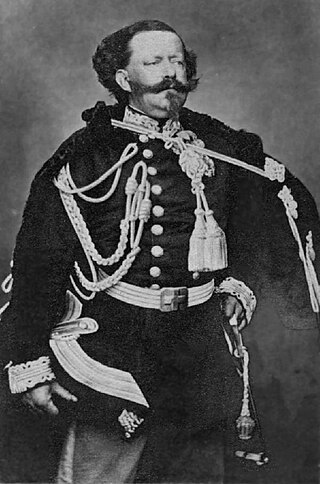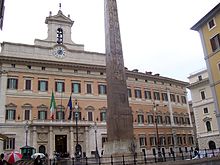History
Its electors were initially selected by wealth and then by literacy, before the introduction of universal suffrage for all men over 21 in 1919. It was elected using a system that was based on both majorities and proportionality.
It was based in the Palazzo Carignano in Turin (1861–1865), the Palazzo Vecchio in Florence (1865–1871), and finally the Palazzo Montecitorio (1871–1939). It was formed at the same time as the Kingdom of Italy in 1861, though its first sitting is known as the 8th Legislature of the Kingdom of Italy, since the 1st to 7th Legislatures are those of the Kingdom of Sardinia.
Its last sitting was the 29th Legislature of the Kingdom of Italy, which ended in 1939 when the Chamber voted to dissolve itself and replace itself with the Chamber of Fasces and Corporations.

Victor Emmanuel II was King of Sardinia from 23 March 1849 until 17 March 1861, when he assumed the title of King of Italy and became the first king of an independent, united Italy since the 6th century, a title he held until his death in 1878. Borrowing from the old Latin title Pater Patriae of the Roman emperors, the Italians gave him the epithet of Father of the Fatherland.

The Statuto Albertino was the constitution granted by King Charles Albert of Sardinia to the Kingdom of Sardinia on 4 March 1848 and written in Italian and French. The Statute later became the constitution of the unified Kingdom of Italy and remained in force, with changes, until 1948. Charles Albert did not want to grant a Constitutional Charter so he attempted to maintain as much power as he could even though the Statute marked the end of his absolute monarchy.

The Senate of the Republic, or simply the Senate, is the upper house of the bicameral Italian Parliament. The two houses together form a perfect bicameral system, meaning they perform identical functions, but do so separately. Pursuant to the Articles 57, 58, and 59 of the Italian Constitution, the Senate has 200 elective members, of which 196 are elected from Italian constituencies, and 4 from Italian citizens living abroad. Furthermore, there is a small number of senators for life, either appointed or ex officio. It was established in its current form on 8 May 1948, but previously existed during the Kingdom of Italy as Senato del Regno, itself a continuation of the Senato Subalpino of Sardinia established on 8 May 1848. Members of the Senate are styled Senator or The Honourable Senator and they meet at Palazzo Madama, Rome.

The Chamber of Deputies is the lower house of the bicameral Italian Parliament. The two houses together form a perfect bicameral system, meaning they perform identical functions, but do so separately. The Chamber of Deputies has 400 seats, of which 392 will be elected from Italian constituencies, and 8 from Italian citizens living abroad. Deputies are styled The Honourable and meet at Palazzo Montecitorio.

The Residences of the Royal House of Savoy are a group of buildings in Turin and the Metropolitan City of Turin, in Piedmont. It was added to the UNESCO World Heritage Sites list in 1997.

The County of Nice is a historical region of France located around the southeastern city of Nice and roughly equivalent to the modern arrondissement of Nice.

The Kingdom of Italy was a state that existed from 17 March 1861, when Victor Emmanuel II of Sardinia was proclaimed King of Italy, until 2 June 1946, when civil discontent led to an institutional referendum to abandon the monarchy and form the modern Italian Republic. The kingdom was established through the unification of several states over a decades-long process, called the Risorgimento. That process was influenced by the Savoy-led Kingdom of Sardinia, which can be considered Italy's legal predecessor state.

The Gazzetta Ufficiale della Repubblica Italiana is the official journal of record of the Italian government. It is published by the Istituto Poligrafico e Zecca dello Stato in Rome.

The Senate of the Kingdom of Italy was the upper house of the bicameral parliament of the Kingdom of Italy, officially created on 4 March 1848, acting as an evolution of the original Subalpine Senate. It was replaced on 1 January 1948 by the present-day Senate of the Republic. All of its members were appointed by the King.

The Subalpine Senate was the upper house of the Kingdom of Sardinia and one of the two houses of its bicameral parliament, the other being the Chamber of Deputies. It was set up in 1848 following the fusion of the Savoyard states. It became the Senate of the Kingdom of Italy upon the unification of Italy in 1861. It is the direct ancestor of the present Italian Senate. Its name was a reference to the Napoleonic Subalpine Republic.
Agenzia Stefani was the leading press agency in Italy from the mid-19th century until the end of World War II. It was founded by Guglielmo Stefani on 26 January 1853 in Turin, and was closed on 29 April 1945 in Milan.

The Adriatic railway is the railway from Ancona to Lecce that runs along the Adriatic Coast of Italy, following it almost all of the way. It is one of the main lines of the Italian rail system and links the northern cities with the most important productive areas of central and southern Italy.
The Right group, later called Historical Right by historians to distinguish it from the right-wing groups of the 20th century, was an Italian conservative parliamentary group during the second half of the 19th century. After 1876, the Historical Right constituted the Constitutional opposition toward the left governments. It originated in the convergence of the most liberal faction of the moderate right and the moderate wing of the democratic left. The party included men from heterogeneous cultural, class, and ideological backgrounds, ranging from Anglo-Saxon individualist liberalism to Neo-Hegelian liberalism as well as liberal-conservatives, from strict secularists to more religiously-oriented reformists. Few prime ministers after 1852 were party men; instead they accepted support where they could find it, and even the governments of the Historical Right during the 1860s included leftists in some capacity.

Lorenzo Nicolò Pareto was an Italian geologist and statesman.
Freemasonry in Italy dates to the first half of the eighteenth century. Its success largely depended on the lack of enthusiasm with which Papal bans on the order were enforced in the various states, but after the end of the Napoleonic regime, Freemasonry was suppressed in most of the peninsula. The start of the unification process in 1859 saw a revival in Freemasonry. Giuseppe Garibaldi, a leader of Italian unification, was an active Mason and a keen supporter of the craft. In the 1920s Freemasonry was again suppressed under Fascism but revived again after the fall of Benito Mussolini. Today's Italy contains a wide variety of Masonic observances, regular, liberal, male, female and mixed.

The Chamber of Deputies was the lower house of the Kingdom of Sardinia and one of the two houses of its bicameral parliament, the other being the Subalpine Senate. It became the Chamber of Deputies of the Kingdom of Italy upon the unification of Italy in 1861.

The Parliament of the Kingdom of Sardinia was the bicameral parliament of the Kingdom of Sardinia.

The Parliament of the Kingdom of Italy was the bicameral parliament of the Kingdom of Italy. It was established in 1861 to replace the Parliament of the Kingdom of Sardinia and lasted until 18 June 1946, when it was replaced by the present-day Italian Parliament. It was formed of a lower house and an upper house.

A naval arms race between the Austrian Empire and Italy began in the 1860s when both ordered a series of ironclad warships, steam-propelled vessels protected by iron or steel armor plates and far more powerful than all-wood ships of the line. These ships were constructed to establish control over the Adriatic Sea in the event of a conflict between the two countries.

The proclamation of the Kingdom of Italy happened with a normative act of the Savoyard Kingdom of Sardinia — the law 17 March 1861, n. 4761 — with which Victor Emmanuel II assumed for himself and for his successors the title of King of Italy. 17 March is commemorated annually by the anniversary of the unification of Italy, a national holiday established in 1911 on the occasion of the 50th anniversary, and also celebrated, in the Republican era, in 1961 and 2011.

















